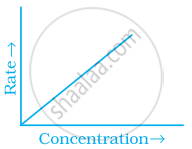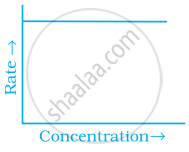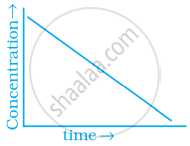Advertisements
Advertisements
Question
Mention the factors that affect the rate of a chemical reaction.
Solution
The factors that affect the rate of a reaction are as follows:
(i) Nature of the reactant - The rate of reaction depends on the nature of the reactant. For instance, ionic molecules react more quickly than covalent ones.
(ii) State of reactants - Solid reactions are slower, liquid reactions are faster, and gas reactions are very quick.
(iii) Temperature - The rate of reaction is mainly affected by temperature. Every 10°C rise in temperature leads to an increased rate of reaction by 2-3 times.
`(r_(t + 10))/r_t` = 2 − 3
This ratio is called the temperature coefficient.
There are two reasons why the rate of reaction increases with increasing temperature.
- Increasing temperature raises the average kinetic energy of reactant molecules, increasing the rate of collisions.
- As temperature rises, the number of molecules with threshold energy increases, resulting in more active molecules. As a result, the number of effective collisions grows. As a result, the rate of reaction rises.
(iv) Concentration - The rate of reaction depends on the concentration of reactants.
Rate = k × Cn, where n = order of reaction, C = concentration of reactant.
(v) Catalyst - The presence of a catalyst changes the rate of the reaction. It lowers the activation energy by producing a chemical intermediate, lowering the potential energy barrier. Thus, the rate of reaction increases.
APPEARS IN
RELATED QUESTIONS
For a reaction: 
Rate = k
(i) Write the order and molecularity of this reaction.
(ii) Write the unit of k.
Write two factors that affect the rate of reaction.
For the hydrolysis of methyl acetate in aqueous solution, the following results were obtained :
| t/s | 0 | 30 | 60 |
| [CH3COOCH3] / mol L–1 | 0.60 | 0.30 | 0.15 |
(i) Show that it follows pseudo first order reaction, as the concentration of water remains constant.
(ii) Calculate the average rate of reaction between the time interval 30 to 60 seconds.
(Given log 2 = 0.3010, log 4 = 0.6021)
A reaction is second order with respect to a reactant. How is the rate of reaction affected if the concentration of the reactant is doubled?
In a reaction between A and B, the initial rate of reaction (r0) was measured for different initial concentrations of A and B as given below:
| A/mol L−1 | 0.20 | 0.20 | 0.40 |
| B/mol L−1 | 0.30 | 0.10 | 0.05 |
| r0/mol L−1 s−1 | 5.07 × 10−5 | 5.07 × 10−5 | 1.43 × 10−4 |
What is the order of the reaction with respect to A and B?
Write resonating structures of ozone.
Write the principle behind the following methods of refining:
Hydraulic washing
For a complex reaction:
(i) order of overall reaction is same as molecularity of the slowest step.
(ii) order of overall reaction is less than the molecularity of the slowest step.
(iii) order of overall reaction is greater than molecularity of the slowest step.
(iv) molecularity of the slowest step is never zero or non interger.
For which type of reactions, order and molecularity have the same value?
In a reaction if the concentration of reactant A is tripled, the rate of reaction becomes twenty seven times. What is the order of the reaction?
Why can we not determine the order of a reaction by taking into consideration the balanced chemical equation?
Match the graph given in Column I with the order of reaction given in Column II. More than one item in Column I may link to the same item of Column II.
| Column I | Column II | |
| (i) |  |
|
| (ii) |  |
(a) 1st order |
| (iii) |  |
(b) Zero-order |
| (iv) |  |
Assertion: Order of the reaction can be zero or fractional.
Reason: We cannot determine order from balanced chemical equation.
Assertion: Order and molecularity are same.
Reason: Order is determined experimentally and molecularity is the sum of the stoichiometric coefficient of rate determining elementary step.
Assertion: Rate constants determined from Arrhenius equation are fairly accurate for simple as well as complex molecules.
Reason: Reactant molecules undergo chemical change irrespective of their orientation during collision.
Use Molecular Orbital theory to determine the bond order in each of species, [He2j+ and [He2]2+?
For a reaction R → p the concentration of reactant change from 0.03 m to 0.02 m in minute, calculate the average rate of the reaction using the unit of second.
For a reaction 1/2 A ⇒ 2B, rate of disappearance of A is related 't o the appearance of B by the expression:
Identify the order of reaction from the following unit for its rate constant:
L mol–1s–1
Assertion (A): Order of reaction is applicable to elementary as well as complex reactions.
Reason (R): For a complex reaction, molecularity has no meaning.
